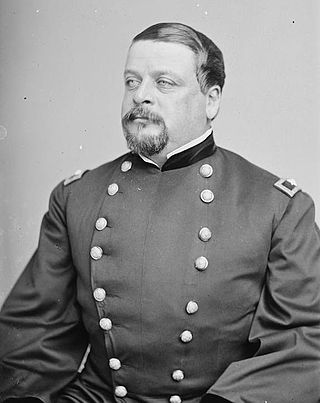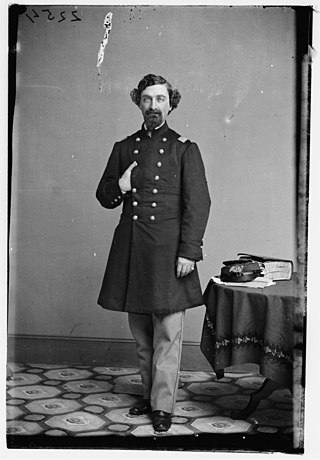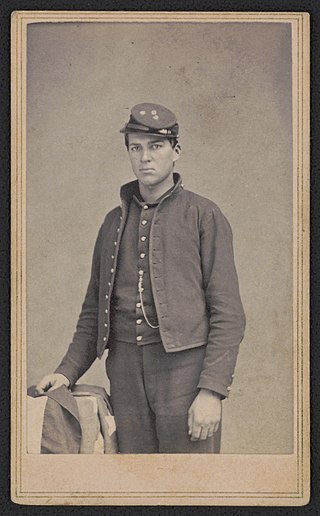
The 15th Pennsylvania Cavalry Regiment, known as the Anderson Cavalry and the 160th Volunteers, was a three-year cavalry regiment in the Union Army during the American Civil War. It was recruited and formed in the summer of 1862 by officers and men of the Anderson Troop, an independent company of the Pennsylvania Volunteers that had been mustered the previous November.
4th Michigan Cavalry Regiment was a regiment of cavalry in the Union Army during the American Civil War fighting in the western front as part of the Army of the Cumberland. It was noted as being the regiment that captured the fleeing President of the Confederate States of America, Jefferson Davis, as the Confederacy collapsed in the spring of 1865.
The 1st Wisconsin Cavalry Regiment was a volunteer cavalry regiment that served in the Union Army during the American Civil War. The regiment is most notable as one of two cavalry regiments credited with the final capture of Confederate president Jefferson Davis on May 10, 1865.
The 6th Indiana Infantry Regiment was an infantry regiment from the State of Indiana that served in the Union Army during the American Civil War. This regiment was the senior Indiana regiment of the Civil War, as it was numbered first in sequence after the five Indiana volunteer regiments which had served in the Mexican–American War. The regiment was originally mustered-in for a three-month period of service between April and August 1861, but after its initial term of service had expired it was re-formed in September 1861 for a further three-year period, before being mustered out in September 1864.
The 7th Regiment Indiana Volunteer Infantry was an infantry regiment from the State of Indiana that served in the Union Army during the American Civil War.
Galvanized Yankees was a term from the American Civil War denoting former Confederate prisoners of war who swore allegiance to the United States and joined the Union Army. Approximately 5,600 former Confederate soldiers enlisted in the United States Volunteers, organized into six regiments of infantry between January 1864 and November 1866. Of those, more than 250 had begun their service as Union soldiers, were captured in battle, then enlisted in prison to join a regiment of the Confederate States Army. They surrendered to Union forces in December 1864 and were held by the United States as deserters, but were saved from prosecution by being enlisted in the 5th and 6th U.S. Volunteers. An additional 800 former Confederates served in volunteer regiments raised by the states, forming ten companies. Four of those companies saw combat in the Western Theater against the Confederate Army, two served on the western frontier, and one became an independent company of U.S. Volunteers, serving in Minnesota.

Alfred Gibbs was a career officer in the United States Army who served as an officer during the Mexican-American War and Apache Wars. He served as a brigadier general in the Union Army during the American Civil War.
The 7th Illinois Cavalry Regiment was a cavalry regiment that served in the Union Army during the American Civil War.
The 21st Iowa Infantry Regiment was an infantry regiment that served in the Union Army during the American Civil War.
The 30th Regiment Illinois Volunteer Infantry was an infantry regiment that served in the Union Army during the American Civil War.
The 1st Delaware Infantry Regiment, later known as the 1st Delaware Veteran Infantry Regiment was a United States volunteer infantry regiment raised for Union Army service in the American Civil War. Part of the II Corps it served in the Eastern Theater of the American Civil War.

The 5th New York Veteran Infantry Regiment was an Infantry Regiment that served in the Union Army during the American Civil War. The regiment was known as "Duryée‘s Zouaves." The regiment had two uniforms during its time. The first uniform consisted of a medium blue zouave jacket with red trimming, a grey shirt, a red sash with sky blue trimming, red chasseur trousers with yellow piping, a red fez with a yellow tassel, and a white turban. The second and official uniform consisted of a dark blue zouave jacket with red trimmings in the Hawkin Zouave design, a dark blue zouave vest with red trimming, baggy red trousers, a red sash with sky blue trimming,a red fez with a yellow tassel, and a white turban.

32nd Regiment Indiana Volunteer Infantry was a Union Army infantry regiment during the American Civil War. It was also known as Indiana's "1st German" regiment because its members were mainly of German descent. Organized at Indianapolis, the regiment's first recruits mustered into service on August 24, 1861. From 1861 to 1865, the 32nd Indiana was attached to the first Army of the Ohio and the Army of the Cumberland, where it served in the Western Theater.
The 6th Pennsylvania Cavalry was a Union Army cavalry regiment that served in the Army of the Potomac and the Army of the Shenandoah during the American Civil War. It was formed in 1861 as the Philadelphia Light Cavalry and the 70th Regiment of the Pennsylvania Volunteers by Richard H. Rush who also served as colonel from 1861 to 1862. At the request of Major General George B. McClellan, the regiment was equipped with lances which prompted the unit to be known as "Rush's Lancers." The lances proved ineffective in battle and the regiment was issued carbine rifles in 1863. The regiment served in many of the key battles in the Eastern theater of the American Civil War and were mustered out in August 1865.

The 1st Tennessee Cavalry Regiment was a cavalry regiment that served in the Union Army during the American Civil War. It was also known as 1st East Tennessee Cavalry. The regiment was organized and was nominally commanded by Robert Johnson, the second son of Tennessee politician and Southern Unionist Andrew Johnson, but in truth the regimental commander was James P. Brownlow, the second son of Parson Brownlow.
The 19th New York Cavalry Regiment was a cavalry regiment that served in the Union Army during the American Civil War.

The 130th New York Infantry Regiment was an infantry regiment that served in the Union Army during the American Civil War.

The 6th Regiment New York Heavy Artillery, U.S. Volunteers, the "Anthony Wayne Guard", was an artillery regiment of the Union Army during the American Civil War. It was originally mustered in as the 135th New York Volunteer Infantry Regiment, and served as both artillery and infantry.

The 17th New York Infantry Regiment was an infantry regiment in the Union Army during the American Civil War.

The 2nd New York Cavalry Regiment, officially known as the 2nd Regiment, New York Volunteer Cavalry, was a unit of the Union Army during the American Civil War. It served with the Army of the Potomac and fought in Stoneman's 1863 raid, the Wilson–Kautz Raid, and the Battle of Appomattox Station.







